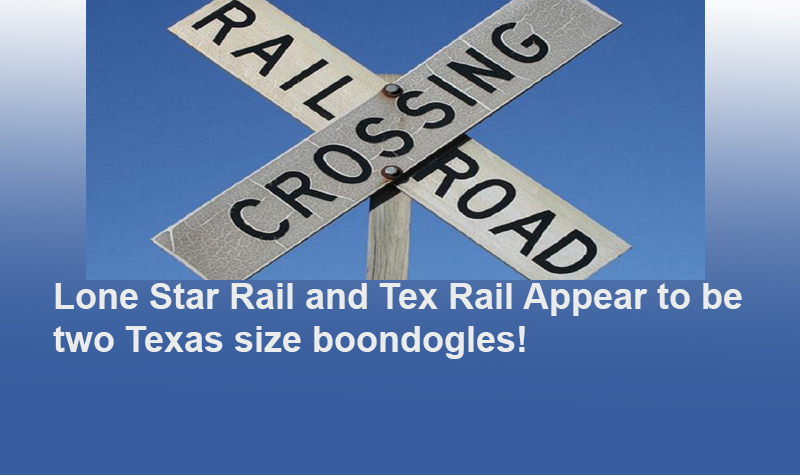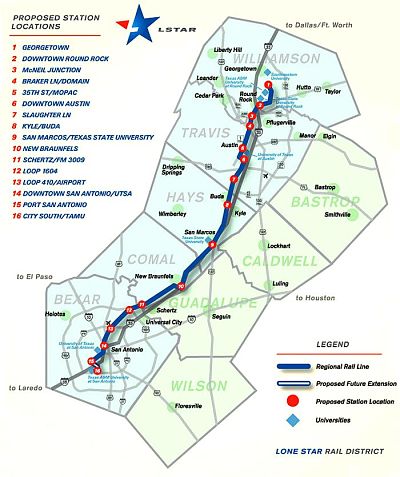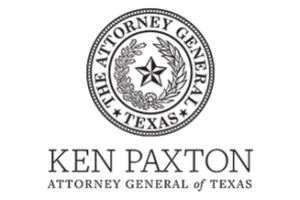By Kenric Ward, Guest Column from Watchdog
Its designated route blocked, the faltering Lone Star Rail project could lose its funding lifeline next month.
Conley, who chairs the 20-member Capital Area Metropolitan Planning Organization, says it’s time for the fantasy to end.The controversial commuter-rail venture hit a wall when Union Pacific Railroad refused to turn over its tracks to LSR. But advocates continue to pay for a two-year environmental impact statement at a cost of up to $30 million.
“We no longer have a route,” he said. “I don’t believe they have a viable project. To move forward is a waste of taxpayer money.
 END OF THE LINE? ”CAMPO pledged $20 million to LSR, with $12 million of that spent thus far. Conley said he will propose that all unspent funds be returned to “close it out properly.” Will Conley, who chairs the Capital Area Metropolitan Planning Organization, will propose cutting off funding of the controversial Lone Star Rail project. The Hays County Commission unanimously opposes funding the 77-mile rail line that would connect Austin and San Antonio. Hays lies between the two cities.
END OF THE LINE? ”CAMPO pledged $20 million to LSR, with $12 million of that spent thus far. Conley said he will propose that all unspent funds be returned to “close it out properly.” Will Conley, who chairs the Capital Area Metropolitan Planning Organization, will propose cutting off funding of the controversial Lone Star Rail project. The Hays County Commission unanimously opposes funding the 77-mile rail line that would connect Austin and San Antonio. Hays lies between the two cities.

City Council members in San Marcos, the Hays County seat, affirmed their support for Lone Star earlier this month.
“Lone Star has successfully leveraged about $5 million in local investment into over $50 million in state and federal funding commitments to the project,”John Thomaides, Lisa Prewitt and Scott Gregson said in a joint statement.
“That’s something most taxpayers and business people would ordinarily applaud,” they said.
To date, $28 million has been spent — about 1 percent of anticipated total project costs — on planning, engineering and environmental clearances.
James Quintero, director of the Center for Local Governance at the Austin-based Texas Public Policy Foundation, said the rail venture has turned into “another big government boondoggle.”
Noting that the bulk of the spending has gone to consultants, Quintero said “it’s hard to see how throwing more good money after bad on this project will do anything to provide relief for frustrated commuters.”
Conley, whose county commission district encompasses half of San Marcos, said enough is enough, and the voters know it.
“When all the details are exposed, the overwhelming majority of people I represent will feel comfortable” about pulling the plug on Lone Star, he said.
Since the Texas Legislature did not grant taxing authority to the Lone Star Rail District, the train is dependent on other political entities to supply funding.
“The Legislature ensured there would be accountability, and that’s what’s happening now,” Conley said.
Acknowledging the chronic traffic congestion along the I-35 corridor, Conley didn’t rule out an alternative transit project in the future. It just won’t be Lone Star Rail at its proposed cost and configuration.
“We’re looking for proper planning and competence,” he said.
A national transportation expert calls the proposed Lone Star Rail project between Austin and San Antonio a bust for taxpayers.
Carrying an initial price tag of $2 billion to $3 billion, the commuter line would take over existing Union Pacific tracks near Interstate 35 and shift freight onto new rails to the east.
“This is how absurd governments can be when it comes to rail,” said Randal O’Toole, a senior fellow at the free-market Cato Institute.
“Union Pacific bought 8,000 miles of Southern Pacific tracks for $3 billion. To spend $3 billion for one short line is not in the realm of possibility,” he told Watchdog.org in an interview.

Chuck DeVore, vice president of national initiatives for the Texas Public Policy Foundation, said reliance on ill-conceived federal subsidies is no way to run a railroad.Lone Star Rail supporters are banking on matching money from Washington, and since the federal New Starts program no longer requires projects to prove “operating efficiency,” LSTAR remains bureaucratically viable.
“Politicians love to cut ribbons on shiny new things and ignore basic bus service that helps the working poor,” DeVore said.
“These (trains) never help relieve traffic. Ridership is infinitesimally small,” he noted.
O’Toole likens policymakers’ fixation with rail projects to the continued installation of streetcars in 1915, when automobiles were starting to hit the roads en masse.
“Technological change will overcome congestion,” he said, predicting the evolving generation of new cars could triple the capacity of existing roads, including I-35.
“Once 25 percent of cars have adaptive cruise control, roughly half of all congestion will go away,” O’Toole forecast.
Meantime, the Cato expert maintained no rail system in America can move more people than a two-lane freeway.
Undaunted, the government-run Lone Star Rail District is working with municipalities to form transportation infrastructure zones. Property tax increases within the zones would go toward train operations and maintenance. Sales tax increases are also being considered.
Regional mobility authorities have the power to impose still more tax hikes while siphoning toll-road revenues into rail ventures.
As I-35 conditions worsen, double-deck commuter buses would be a far cheaper and flexible alternative for frazzled motorists, but public subsidies distort transportation-financing models and suppress market-driven competition.
Indeed, Cato research found that New Starts rail projects can actually worsen congestion while increasing energy use and air pollution.
Yet the “free federal money” train rolls on with encouragement from both political parties. In Austin, legislation prohibiting New Starts from funding additional passenger rail projects in Texas died without a hearing last session.
Terri Hall, president of the nonpartisan Texans Uniting for Reform and Freedom, said local officials have already earmarked $20 million for two or more boarding platforms at unspecified sites.
Approved without public hearings, the platforms will be funded by gasoline taxes. “It’s another diversion of road money, and the public doesn’t have the first clue,” Hall said.
















1 Comments
natalie
Excellent article. If voters understood what an enormous waste of taxpayer dollars these rail projects are, they would VOTE OUT of office those elected officials working against voters and pushing rail. In Tarrant County our major rail pushers are County Judge, Glen Whitley and County Commissioner Gary Fickes. On Colleyville City Council, Mike Taylor is pushing rail.
PLEASE ask our state rep, Giovanni Capriglione what he is doing to help stop TEX Rail. He ran saying he would help us stop TEX Rail but we have not heard from him recently on this issue.
Many thanks to Konni Burton for being a taxpayer hero and working to stop this boondoggle.
Voters, YOU hold the power to stop this by holding your elected officials accountable.
PLEASE start calling and emailing them.
County Judge GLEN WHITLEY (He is the FACE of TEXRail and its #1 cheerleader)
817-884-1441 Monday – Friday, 8 a.m. – 5 p.m.
EMAIL-Glen Whitley
County Commissioner GARY FICKES (Tells some privately he is against TEX RAIL but tells others he supports it. Will NOT speak publicly against TEX Rail or help stop funding. ASK which side he is on.)
817-581-3600 Monday – Friday, 8 a.m. – 5 p.m.
EMAIL-Gary Fickes ggfickes@tarrantcounty.com
State Rep GIOVANNI CAPRIGLIONE (What is he doing to help stop TEX Rail?)
Austin – (512) 463-0690 (512) 463-1004 FaX
Keller- (817) 431-5339
“Giovanni Capriglione”